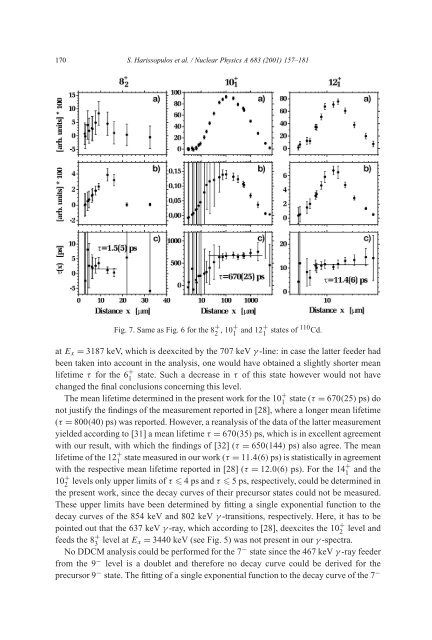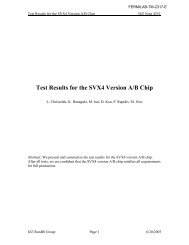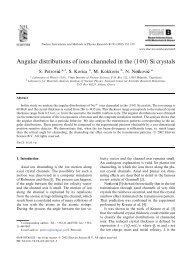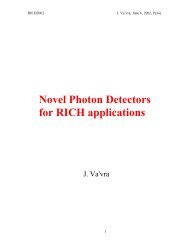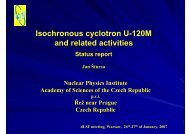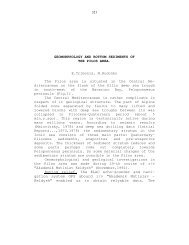Picosecond lifetime measurements in 109Cd and 110Cd
Picosecond lifetime measurements in 109Cd and 110Cd
Picosecond lifetime measurements in 109Cd and 110Cd
Create successful ePaper yourself
Turn your PDF publications into a flip-book with our unique Google optimized e-Paper software.
170 S. Harissopulos et al. / Nuclear Physics A 683 (2001) 157–181<br />
Fig. 7. Same as Fig. 6 for the 8 + 2 ,10+ 1 <strong>and</strong> 12+ 1 states of 110 Cd.<br />
at E x = 3187 keV, which is deexcited by the 707 keV γ -l<strong>in</strong>e: <strong>in</strong> case the latter feeder had<br />
been taken <strong>in</strong>to account <strong>in</strong> the analysis, one would have obta<strong>in</strong>ed a slightly shorter mean<br />
<strong>lifetime</strong> τ for the 6 + 1<br />
state. Such a decrease <strong>in</strong> τ of this state however would not have<br />
changed the f<strong>in</strong>al conclusions concern<strong>in</strong>g this level.<br />
The mean <strong>lifetime</strong> determ<strong>in</strong>ed <strong>in</strong> the present work for the 10 + 1<br />
state (τ = 670(25) ps) do<br />
not justify the f<strong>in</strong>d<strong>in</strong>gs of the measurement reported <strong>in</strong> [28], where a longer mean <strong>lifetime</strong><br />
(τ = 800(40) ps) was reported. However, a reanalysis of the data of the latter measurement<br />
yielded accord<strong>in</strong>g to [31] a mean <strong>lifetime</strong> τ = 670(35) ps, which is <strong>in</strong> excellent agreement<br />
with our result, with which the f<strong>in</strong>d<strong>in</strong>gs of [32] (τ = 650(144) ps) also agree. The mean<br />
<strong>lifetime</strong> of the 12 + 1<br />
state measured <strong>in</strong> our work (τ = 11.4(6) ps) is statistically <strong>in</strong> agreement<br />
with the respective mean <strong>lifetime</strong> reported <strong>in</strong> [28] (τ = 12.0(6) ps). For the 14 + 1<br />
<strong>and</strong> the<br />
10 + 2<br />
levels only upper limits of τ 4ps<strong>and</strong>τ 5 ps, respectively, could be determ<strong>in</strong>ed <strong>in</strong><br />
the present work, s<strong>in</strong>ce the decay curves of their precursor states could not be measured.<br />
These upper limits have been determ<strong>in</strong>ed by fitt<strong>in</strong>g a s<strong>in</strong>gle exponential function to the<br />
decay curves of the 854 keV <strong>and</strong> 802 keV γ -transitions, respectively. Here, it has to be<br />
po<strong>in</strong>ted out that the 637 keV γ -ray, which accord<strong>in</strong>g to [28], deexcites the 10 + 2<br />
level <strong>and</strong><br />
feeds the 8 + 3 level at E x = 3440 keV (see Fig. 5) was not present <strong>in</strong> our γ -spectra.<br />
No DDCM analysis could be performed for the 7 − state s<strong>in</strong>ce the 467 keV γ -ray feeder<br />
from the 9 − level is a doublet <strong>and</strong> therefore no decay curve could be derived for the<br />
precursor 9 − state. The fitt<strong>in</strong>g of a s<strong>in</strong>gle exponential function to the decay curve of the 7 −


